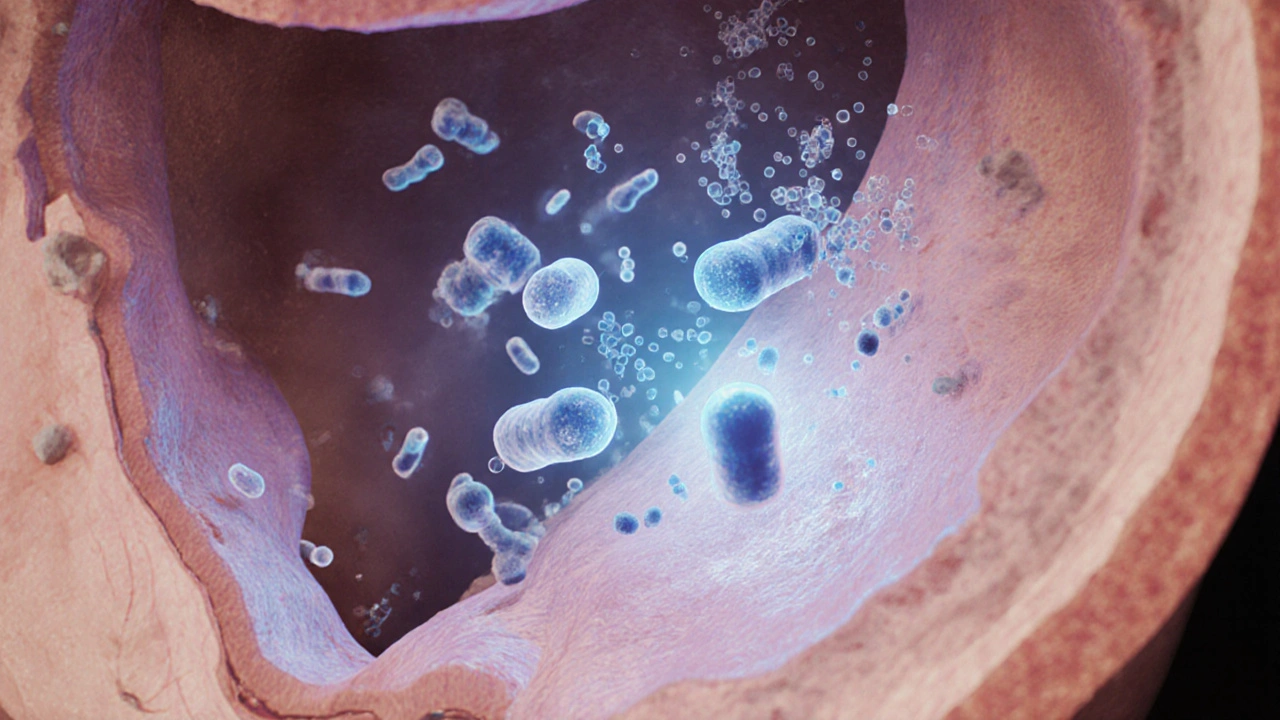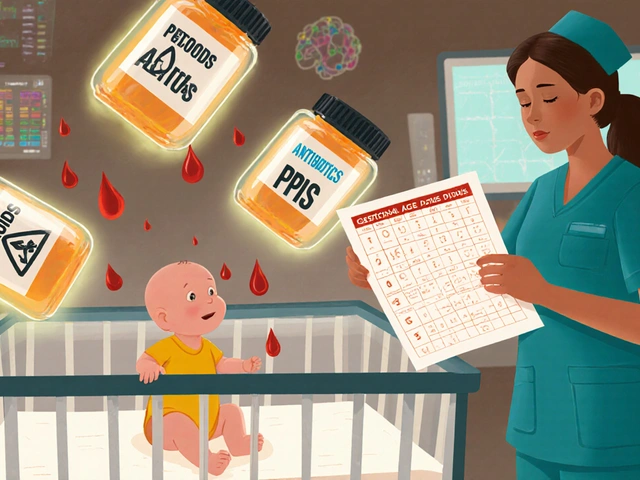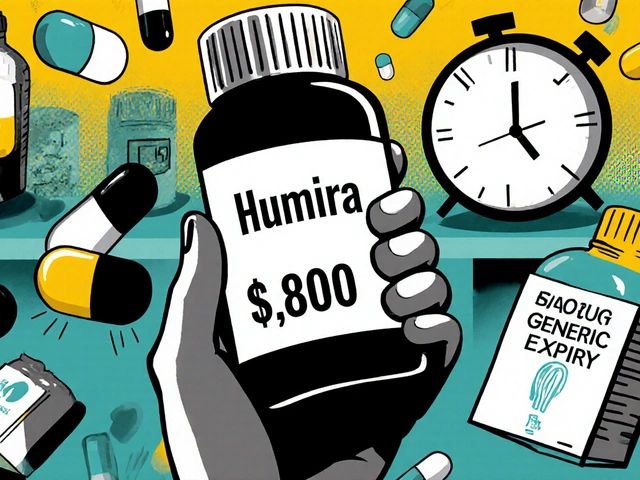Nitrofurantoin vs Other UTI Antibiotics: Detailed Comparison
UTI Antibiotic Choice Guide
Recommended Antibiotics
Detailed Comparison
| Antibiotic | Effectiveness | Resistance Rate | Side Effects | Safety Profile |
|---|
When coping with an uncomplicated urinary tract infection (UTI), choosing the right antibiotic can feel like a gamble. Nitrofurantoin is a synthetic antibiotic that concentrates in the urine and targets common culprits such as Escherichia coli. But it isn’t the only option on the shelf. This guide breaks down how Nitrofurantoin stacks up against the most frequently prescribed alternatives, helping you see when it shines and when another drug might be a safer bet.
Key Takeaways
- Nitrofurantoin works best for lower‑tract infections and is safe for most non‑pregnant adults.
- Trimethoprim‑sulfamethoxazole (TMP‑SMX) offers broader coverage but faces rising resistance.
- Fosfomycin is a single‑dose option ideal for patients with compliance issues.
- Ciprofloxacin provides high potency for complicated cases but carries a higher risk of tendon injury and should be reserved.
- Amoxicillin‑clavulanate is useful when the pathogen produces beta‑lactamase enzymes, yet it may cause more gastrointestinal upset.
How Nitrofurantoin Works
Nitrofurantoin belongs to the nitrofuran class. Once it reaches the urinary tract, bacterial enzymes convert it into reactive compounds that damage bacterial DNA, ribosomal proteins, and cell walls. Because the drug is rapidly excreted unchanged in the urine, systemic exposure stays low, which reduces the chance of side effects outside the bladder.
Key pharmacokinetic facts:
- Absorption: 30-50% oral bioavailability.
- Peak urinary concentration: 4-8hours after a dose.
- Half‑life: 30-60minutes (systemic), but effective urinary levels persist for up to 12hours.
These properties make Nitrofurantoin especially suited for Urinary Tract Infection caused by organisms that stay in the bladder, like Escherichia coli.
Common Alternatives at a Glance
Several antibiotics compete for the same niche. Below are brief snapshots of the most widely used alternatives.
Trimethoprim‑Sulfamethoxazole (TMP‑SMX)
Trimethoprim‑sulfamethoxazole combines two agents that block bacterial folic‑acid synthesis. It’s been a first‑line choice for decades, but its effectiveness is eroding in regions where resistance rates exceed 20%.
Fosfomycin
Fosfomycin is a phosphonic acid derivative that interferes with cell‑wall formation. A single 3g oral dose delivers high urinary concentrations for 48hours, making it handy for patients who struggle with multi‑day regimens.
Ciprofloxacin
Ciprofloxacin, a fluoroquinolone, inhibits bacterial DNA gyrase. It’s potent against many gram‑negative organisms, but its use is limited by warnings about tendon rupture, QT prolongation, and the promotion of multidrug‑resistant strains.
Amoxicillin‑Clavulanate
Amoxicillin‑clavulanate pairs a broad‑spectrum penicillin with a ß‑lactamase inhibitor (clavulanic acid). It’s useful when the infecting bacteria produce ß‑lactamases, but the combination often triggers diarrhea and yeast overgrowth.
Side‑Effect Profiles
Understanding tolerability helps you weigh the real‑world impact of each drug. Below is a quick side‑effect comparison.
- Nitrofurantoin: Nausea, headache, pulmonary reactions (rare, usually reversible).
- Trimethoprim‑sulfamethoxazole: Rash, photosensitivity, rare blood‑cell suppression.
- Fosfomycin: Mild gastrointestinal upset; most patients tolerate the single dose well.
- Ciprofloxacin: Tendonitis, peripheral neuropathy, possible heart rhythm changes.
- Amoxicillin‑clavulanate: Diarrhea, liver enzyme elevation, yeast infections.

Resistance Landscape
Antibiotic resistance is a moving target. The table below captures current (2024) resistance data for the most common uropathogen, Escherichia coli, across the five drugs.
| Antibiotic | Resistance % | Typical Use Cases |
|---|---|---|
| Nitrofurantoin | 4% | Uncomplicated cystitis |
| Trimethoprim‑Sulfamethoxazole | 22% | First‑line in low‑resistance regions |
| Fosfomycin | 6% | Single‑dose for uncomplicated cases |
| Ciprofloxacin | 15% | Complicated UTIs, pyelonephritis |
| Amoxicillin‑Clavulanate | 12% | Beta‑lactamase‑producing strains |
Pregnancy and Pediatric Considerations
Safety in special populations often tips the balance.
- Nitrofurantoin is generally avoided after 36weeks gestation because of potential neonatal hemolysis, but it’s considered safe in the first two trimesters.
- Trimethoprim‑sulfamethoxazole is contraindicated in the first trimester and near delivery due to folate antagonism.
- Fosfomycin has limited data but is viewed as low risk, making it a reasonable option when other drugs are unsuitable.
- Ciprofloxacin is discouraged during pregnancy because of cartilage toxicity concerns in the fetus.
- Amoxicillin‑clavulanate is pregnancy‑category B and often used when beta‑lactam coverage is needed.
Choosing the Right Agent: Clinical Decision Flow
Below is a step‑by‑step approach you can follow when prescribing or selecting a therapy for uncomplicated cystitis.
- Confirm the infection is Urinary Tract Infection and that the patient is not pregnant beyond 36weeks.
- Check local resistance patterns (often published by public health agencies). If Nitrofurantoin resistance is <5%, it becomes the first choice.
- If the patient has a known sulfa allergy, skip TMP‑SMX.
- For patients with poor adherence, consider a single‑dose Fosfomycin.
- Reserve Ciprofloxacin for cases with suspected upper‑tract involvement or when other agents fail, and counsel about tendon risk.
- When beta‑lactamase‑producing bacteria are suspected (e.g., prior treatment failure), choose Amoxicillin‑clavulanate.
Pros and Cons Summary
| Drug | Pros | Cons |
|---|---|---|
| Nitrofurantoin | Low resistance, urine‑specific, cheap | Not for kidney impairment, avoid late pregnancy |
| Trimethoprim‑SMX | Broad coverage, inexpensive | Rising resistance, sulfa allergy issues |
| Fosfomycin | Single dose, good for compliance | Higher cost, limited pediatric data |
| Ciprofloxacin | High potency, good for complicated UTIs | Tendon risk, promotes multidrug resistance |
| Amoxicillin‑clavulanate | Effective against beta‑lactamase producers | GI upset, drug‑interactions |
Frequently Asked Questions
Can I use Nitrofurantoin if I have kidney disease?
Nitrofurantoin requires a creatinine clearance above 60mL/min to achieve therapeutic urine concentrations. For patients with moderate to severe renal impairment, it’s generally avoided because the drug may not reach effective levels and toxicity risk rises.
Why is resistance so low for Nitrofurantoin?
Nitrofurantoin’s multiple mechanisms of action make it hard for bacteria to develop simultaneous mutations. Additionally, its high urinary concentration means bacteria are exposed to a potent dose that overwhelms most resistant strains.
Is a single dose of Fosfomycin enough for a severe infection?
For uncomplicated cystitis, the single 3g dose is highly effective. In cases of pyelonephritis or complicated UTIs, clinicians usually add a second oral agent or switch to a longer‑course fluoroquinolone.
What should I watch for when taking Ciprofloxacin?
Patients should stop the drug immediately if they feel sudden joint pain, tendon swelling, or notice a rapid heartbeat. Those with a history of tendon disorders or taking corticosteroids are at higher risk.
Can I take Nitrofurantoin while breastfeeding?
Only trace amounts appear in breast milk, and most guidelines consider it compatible with breastfeeding. However, if the infant shows signs of jaundice or hemolysis, discuss alternatives with a healthcare professional.
By lining up the pharmacology, resistance data, side‑effect profiles, and special‑population warnings, you can pick the antibiotic that best fits the infection and the patient. Nitrofurantoin remains a solid first‑line option for most uncomplicated UTIs, but knowing when to pivot to TMP‑SMX, Fosfomycin, Ciprofloxacin, or Amoxicillin‑clavulanate ensures you stay one step ahead of resistance and adverse events.






16 Comments
Shivaraj Karigoudar
October 4 2025When delving into the nitrofurantoin vs. alternative UTI therapeutics landscape, one must first appreciate the pharmacokinetic idiosyncrasies that render nitrofurantoin uniquely efficacious for lower‑tract infections. The drug's oral bioavailability hovers around 30‑50%, yet renal excretion ensures urinary concentrations that surpass the MIC for common uropathogens by several fold. Moreover, the nitrofuran core undergoes bacterial enzymatic reduction, birthing reactive intermediates that wreak havoc on DNA, ribosomal proteins, and cell‑wall integrity – a multi‑targeted MoA that curtails resistance emergance.
In contrast, trimethoprim‑sulfamethoxazole (TMP‑SMX) hinges on folic‑acid pathway inhibition, a mechanism that, while historically robust, now grapples with escalating resistence rates upward of 20% in many locales. The sulfonamide component also predisposes patients to hypersensitivity reactions and, rarer, hematologic toxicities.
Fosfomycin, with its singular high‑dose regimen, capitalizes on inhibition of MurA, curbing peptidoglycan synthesis. Its 48‑hour urinary dwell time offers convenience, yet its spectrum can be narrower, and the cost may be prohibitive for some health systems.
Ciprofloxacin, a fluoroquinolone, exerts potent DNA gyrase inhibition but is shadowed by tendonitis, peripheral neuropathy, and the specter of rapid gram‑negative resistance development, especially in regions with heavy fluoro‑use.
Amoxicillin‑clavulanate extends coverage via β‑lactamase inhibition, but the combination frequently precipitates antibiotic‑associated diarrhea and risk of C. difficile colitis.
From a safety perspective, nitrofurantoin is generally well tolerated in non‑pregnant adults; however, its avoidance after 36‑weeks gestation is prudent due to potential neonatal hemolysis. The drug's pulmonary toxicity, though rare, necessitates vigilance in patients with pre‑existing lung disease.
Clinicians must also weigh drug‑drug interactions; nitrofurantoin's minimal CYP involvement spares many patients from metabolic complications seen with ciprofloxacin's CYP1A2 induction.
In settings where local E. coli resistence to nitrofurantoin remains below 5%, it should remain first‑line for uncomplicated cystitis, reserving broader‑spectrum agents for cases with documented resistance or complicating factors.
Finally, stewardship considerations dictate that using a narrow‑spectrum agent like nitrofurantoin curbs collateral damage to the microbiome, reducing the selection pressure for multidrug‑resistant organisms. This principle underpins modern infectious disease guidelines and should steer therapeutic decisions whenever feasible.
Fabio Max
October 8 2025Great breakdown – definitely helps clinicians pick the right drug for uncomplicated cystitis.
Darrell Wardsteele
October 11 2025This guide is useless without acknowledging the US's superior antibiotic stewardship.
Madeline Leech
October 14 2025Honestly, nitrofurantoin is the only sensible choice for uncomplicated cystitis unless you have a compelling reason to deviate; the data on resistance and safety are crystal clear.
Andrea Rivarola
October 18 2025While I respect the confidence in nitrofurantoin, it's worth noting that patient-specific factors can sway the decision. For instance, individuals with impaired renal function may not achieve adequate urinary concentrations, thereby diminishing efficacy. Additionally, the rare pulmonary toxicity you mentioned, though uncommon, should prompt clinicians to monitor patients with pre‑existing lung disease closely. In pediatric populations, the taste and tolerability of the medication might affect adherence, making a single‑dose option like fosfomycin attractive despite its slightly higher resistance profile. Lastly, regional resistance patterns can shift quickly; staying updated with local antibiograms ensures that we aren't inadvertently prescribing a drug that's losing its edge. All these nuances underscore why a one‑size‑fits‑all approach rarely works in antimicrobial stewardship.
Tristan Francis
October 21 2025They don't tell you that the pharma companies are hiding the real side effects.
Keelan Walker
October 25 2025Wow, that conspiracy angle is something else 🤔
Anyway, nitrofurantoin really does shine for uncomplicated cystitis because it stays in the bladder and hits the bugs hard 💥
But remember, if the patient’s GFR is below 60 ml/min, you might not get the levels you need 😕
And yes, the rare lung issues are real, so keep an eye on any new cough or shortness of breath 🌬️
For pregnant folks, it’s safe early on but you gotta stop before week 36 to avoid neonatal hemolysis, as the literature shows 📚
Overall, keep it simple, use local resistance data, and reserve the fluoroquinolones for when you truly need them 🚀
Heather Wilkinson
October 28 2025Thanks for the clear summary! 😊 It’s always helpful to have a quick reference when deciding on therapy.
April Conley
November 1 2025Actually nitrofurantoin isn’t always the best – consider renal function first.
Sophie Rabey
November 4 2025Oh great, another “nitrofurantoin is king” post – because we all love seeing the same old regimen being touted without any nuance about MIC breakpoints.
Bruce Heintz
November 8 2025👍 Totally get the frustration, but nitrofurantoin does have a solid track record when used appropriately. It’s all about picking the right patient.
richard king
November 11 2025In the grand theater of antimicrobial choices, nitrofurantoin takes the stage like a seasoned virtuoso, its low‑resistance melody resonating through the aisles of outpatient clinics. Yet, the understudy-fosfomycin-waits in the wings, ready to deliver a one‑act performance for those who stumble on adherence. Meanwhile, the flamboyant ciprofloxacin, with its dazzling fluoro‑quinolone fireworks, often robs the audience of future options, leaving a lingering after‑taste of tendon trouble. The plot thickens when pregnancy enters the scene, casting nitrofurantoin as both hero and villain, safe in early trimesters yet tipped off the stage after week thirty‑six. Such drama reminds us that antimicrobial stewardship is less about the single star and more about an ensemble cast, each actor playing its part under the spotlight of local resistance data.
William Lawrence
November 15 2025Sure, drama aside, the data is clear-nitrofurantoin isn’t always the answer.
Grace Shaw
November 18 2025While I appreciate the enthusiasm surrounding nitrofurantoin, a meticulous appraisal of the available evidence suggests a more tempered approach. The pharmacodynamic profile, characterized by a modest serum half‑life yet sustained urinary concentrations exceeding the minimal inhibitory concentration for predominant uropathogens, confers undeniable therapeutic advantage in uncomplicated cystitis. Nevertheless, the drug’s efficacy is intrinsically linked to renal function; patients with an estimated glomerular filtration rate below 60 mL/min may fail to achieve therapeutic urinary levels, thereby compromising clinical outcomes. Additionally, the rare but documented pulmonary adverse events underscore the necessity for vigilant monitoring, particularly in individuals with antecedent pulmonary pathology. In the context of pregnancy, the risk–benefit calculation must incorporate the gestational period, as nitrofurantoin is deemed acceptable during the first two trimesters but contraindicated after the thirty‑sixth week owing to potential neonatal hemolysis. Comparative analysis with alternative agents-such as fosfomycin’s single‑dose convenience, trimethoprim‑sulfamethoxazole’s broadened spectrum yet rising resistance, and ciprofloxacin’s potency counterbalanced by its propensity for tendon injury-further elucidates the decision matrix. Ultimately, stewardship principles dictate that therapeutic selection be individualized, guided by current local antibiograms, patient comorbidities, and safety considerations, rather than a monolithic endorsement of any single antimicrobial.
Sean Powell
November 22 2025Got it - tailor the choice to the patient, check the local data, and stay safe.
Henry Clay
November 25 2025That’s naive. Most clinicians just follow guidelines without looking at the data. 🙄